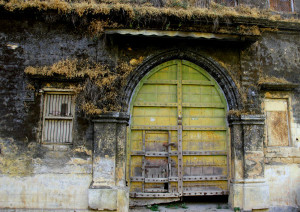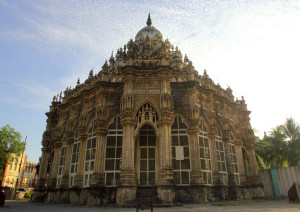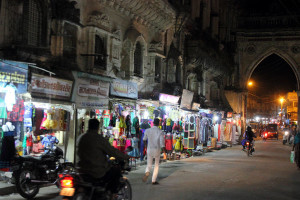by Priyadarshini D
My visit to Junagadh reminds me of a favourite dialogue from the animation series, Shrek. There is an exchange between Shrek and his sidekick Donkey where Shrek attempts to edify Donkey that there is a lot more to ogres than what people think, and that ogres are like onions: they have layers. And so it was, I discovered, with Junagadh too.
The month long trip to Gujarat that my friends and I undertook included a brief pit-stop at Junagadh. Initially, we planned to spend a day there, after spotting some lions at the Gir National Park and before catching a mid-night train for the Little Rann of Kutch. Junagadh is an erstwhile princely state. I was intensely curious to see it after having read about its stormy accession to India. Like the state of Hyderabad, the ruling family in Junagadh was Muslim whereas the subjects were predominantly Hindu. The royal family sought to accede to Pakistan – this despite the absence of a contiguous border with Pakistan – whereas the people of Junagadh preferred to stay with India. A high-stakes political drama followed between the newly independent India and Pakistan, anxious to establish their borders. The accession to India was finally accomplished after many parleys and attempted parleys with Pakistan, maneuvers and outmaneuvers, revolts within the princely state and finally, a show of military strength by India. A fascinating account of the accession is found in Srinath Raghavan’s lively and engaging War and Peace in Modern India. The dramatis personae also includes, albeit very briefly, the eccentric royal of Junagadh, if only to mention his absurd fascination for canines apart from his desire to accede to Pakistan. He preferred canines to his human subjects and is said to have held massive wedding celebrations for a newly married canine couple! But as we drove through the city on our way to Gir, the feeling was one of disappointment. Dusty, grey, old and crumbly, Junagadh looked decidedly uninspiring. So much so, we almost cancelled the stay and planned to go directly to Kutch from Gir. However, inability to garner a hotel refund gave us pause. And so, after much dawdling, and armed with a 19-year-old history student moonlighting as a guide, we set off half-heartedly in the post-noon heat to explore the city.
Our first destination was the makbaras of Mahabbat Khan II and his vazir; a good move by our guide given our lack of enthusiasm. We passed through several localities, mostly residential, on our way there. Narrow streets snaked up and down, walled in by old buildings with faded facades in various states of disrepair. Yet, like the wizened face of an old man, the peeling paints, exposed bricks and mortar, cracks big and small, and worn out, moss-covered entrances merely added character, texture, and a charming laid-back aesthetic in the afternoon heat. In contrast, the makbaras stood in a busier part of the city, amidst a beehive of dusty roads, commercial spaces, blaring horns, teeming humanity and a courthouse – presumably the source of the frenzy. No elegant archways, grand entrances or pretty gardens greeted one to these gorgeous structures. If there existed any, they were lost now. Mahabbat Khan’s makbara is a burst of onion shaped domes sitting atop an intricately carved base of multiple pillars, doors and windows. His vazir’s makbara with its four minarets is a harmonious composition of different styles of architecture. The vazir’s makbara is called the Taj of the West and rightly so. However, both the makbaras were locked and were beginning to show signs of serious neglect. These monuments have been increasingly suffering from vandalism, our guide informed us. As we sped away towards our next destination, the beehive seemed to rapidly close in on them. Despite the onslaught, they continued to stand in lonely splendour. For how long? – I wondered.
The Uparkot Fort carried forward the general theme of dirt and neglect. The dilapidated entrance and the overgrowth inside shockingly belied the thought and self-sufficiency behind the structures within the precincts, not to mention the incredible stretch of history it seems to have survived. The fort is situated on an elevation in the middle of the city to provide a 360-degree view to its approach – a critical feature for forts generally. It also offers a good view of the distant Girnar mountains known for their Jain temples. Within the fort complex lay ancient Buddhist caves dating back to Ashoka the Great, two massive stepwells built around the 12th century during the Solanki dynasty, a Juma masjid built over an earlier temple by the later Muslim rulers of Junagadh, and two cannons of Egyptian provenance called Neelam and Manek from the 1500’s. The cannons were left behind by Turkish forces fighting the Portuguese on behalf of the then ruler of Junagadh. The complex also housed stables, sun temples and a huge granary. The guide mentioned a talaab (pond) in the vicinity, that still supplied water to the town. However, we never got to see it due to time constraints. I was in awe of the stepwells – and I hadn’t yet seen the famous Rani ki Vav in Patan. Climbing down the uneven and sometimes extremely narrow stone steps towards the circular well in the far distance, could get a bit claustrophobic. The rock walls gain height and begin to loom menacingly above you as you descend. The well is however mostly covered with refuse now, denying even a glimpse of what lies underneath. How on earth did they manage to cut through rock for 200 or 300 feet?
We hurried out of the fort as the crimson glow of sunset settled around us, and headed towards the principal market area. By this time we were carrying serious regret along with hunger pangs. It was clear the city needed more time to explore. We paused briefly at the Jai Ambe juice centre that came highly recommended by the Lonely Planet. Located close to an arched entrance leading into the market, it gave us a vantage point to consider the throng of people, colourful moto-rickshaws and a massive colonial style building as we sipped refreshing milkshakes. The guide informed us that the building would soon be torn down to make way for modern amenities.
The circle-shaped market was a kaleidoscope of shops, wares, colorfully-dressed mannequins and humans lining its inner perimeter and centre. Tall, elegant buildings sporting latticed jarokkas stood like benign guardians over the cheerfully-lit shops, their upper reaches disappearing into the night. We momentarily stepped into a maze of tiny lanes and hardware shops behind these buildings, in search of local savouries and dry fruits the market seemed known for. I wondered if the general rundown atmosphere of the buildings could possibly be because the owners had fled to Pakistan after the accession. Apparently, the ancestral home of late Parveen Babi, a famous Bollywood actress of the 70’s and 80’s, also lay somewhere in the maze.
Soon it turned dark and we had to board the train. We reluctantly set off to the hotel. Girnar, Reay Gate, Clock Tower, Central Jail, Aina Mahal, numerous public gardens and the zoo where the Asiatic lions were successfully bred – the guide rattled off when asked about other sights. We had barely skimmed the surface of Junagadh, it seemed. Beneath the general neglect lay a cornucopia of buildings, monuments, streets and markets reminiscent of the aesthetics and vision of bygone eras and of rulers past. It appears that a conservation plan was in the works way back in the late 80’s[1]. As we hurried back to the hotel, we vowed to return to Junagadh for a longer sojourn, and to never again judge a place by its look.
[1] http://indiatoday.intoday.in/story/architectural-marvels-in-junagadh-fall-to-ravages-of-time-and-man/1/323334.html
Pictures by Priyadarshini D








[…] A travel piece published in August 2016 in Spark – https://sparkthemagazine.com/ogres-and-erstwhile-princely-states/ […]